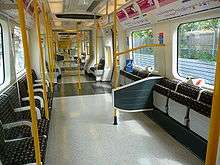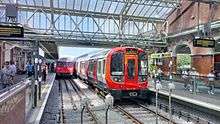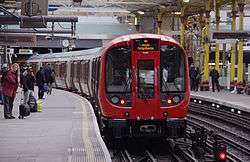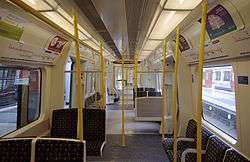London Underground S7 and S8 Stock
| S7 and S8 Stock | |
|---|---|
|
S8 Stock at Farringdon | |
|
S8 interior at Baker Street | |
| In service | 31 July 2010 (formally 2 August 2010) |
| Manufacturer | Bombardier Transportation |
| Built at | Derby Litchurch Lane |
| Family name | Movia |
| Replaced |
|
| Constructed | 2009-present |
| Entered service |
|
| Number under construction | 2 trains |
| Number built | 192 trains by 2016[1] |
| Number in service | 190 trains |
| Formation |
|
| Capacity |
|
| Operator(s) | London Underground |
| Depot(s) |
|
| Line(s) served |
|
| Specifications | |
| Car body construction | Aluminium |
| Train length |
|
| Car length |
|
| Width | 2.92 m (9 ft 7 in)[2] |
| Entry | Level |
| Doors | Six per carriage |
| Maximum speed | 100 km/h (62 mph) |
| Traction system |
IGBT-VVVF (Bombardier MITRAC) |
| Acceleration | 1.3 m/s2 |
| Electric system(s) | 750 V DC fourth rail |
| Current collection method | Contact shoe |
| Track gauge | 1,435 mm (4 ft 8 1⁄2 in) standard gauge |
| Notes | |
|
| |
The S Stock is a fleet of subsurface rolling stock utilized on the London Underground since 2010. Delivered by Bombardier Transportation in Derby, the S Stock was ordered to replace the A60, A62, C69, C77 and D78 stock on the Metropolitan, District, Hammersmith & City, and Circle lines. The order consists of a standardised fleet of 191 trains (1,395 cars), with 1 additional S8 stock train (8 cars) ordered as a part of Metropolitan line extension to Watford Junction (192 trains = 1,403 cars). The stock has two types, S7 and S8, serving different lines, with differences in the arrangement of seating and number of cars. Both types have air-conditioning and low floors to ease accessibility for disabled people, and it is also possible for a passenger to walk from one car to the next while the train is moving, unlike older trains on the network.
The order is said to be the biggest single rolling-stock order in Britain.[2] According to Transport for London, the cost will be £1.5 billion.[3]
Passenger service began on the Metropolitan line in July 2010, the Hammersmith & City line in July 2012, and the Circle and District lines in September 2013. The S Stock completely replaced the A Stock on the Metropolitan line in September 2012 and the C Stock on the Circle and Hammersmith & City lines in February 2014, and started operating on the District line in June 2014; it is expected to fully replace the D Stock on the rest of the District line by December 2016.[4]
Overview
The S designation stands for sub-surface, following the London Underground tradition of designating surface stock with a letter associated with its intended route - A Stock on the Metropolitan line to Amersham,[5] the C Stock on the Circle line and Hammersmith & City line,[6] and D Stock on the District line.[7]
Part of Bombardier's Movia family, the stock consists of 133 S7 seven-car trains for the Circle, District and Hammersmith & City lines and 59 S8 eight-car trains for the Metropolitan line. S8 Stock entered service between 2010 and 2012, operating all services by September 2012.
The stock has faster acceleration than previous stock, at 1.3 m/s2 (2.9 mph per second), but its top speed is 62 mph (100 km/h), 8 mph slower than A Stock but faster than C and D Stocks. During the period of dual operation with both old and new trains, the stock has its performance capped to match that of the older trains in order to comply with signalling constraints and avoid bunching of the service. S8 stock seats 306 passengers compared with 448 for A Stock, a reduction of 32%, but it can accommodate 25% more standing passengers (1,226 compared with 976) and has dedicated space for wheelchairs.[2]
Eventually the voltage will be increased from nominal 630 volts to 750 volts. This will allow for better performance and also for the increased power demands of air-conditioned, fully motored-axle trains, and allow the trains to return energy to the network through regenerative braking.[8]
At present the stock is operated manually, but London Underground will activate automatic train operation once the necessary signalling is in place by 2022.[9] It was initially intended that the upgrade would happen in 2018, but has been delayed.[8]
Features
The stock is air-conditioned throughout: the sub-surface tunnels (unlike deep-level tube lines) allow the exhausted hot air to disperse,[2] and two-thirds of the sub-surface network is in the open air.[10] The stock has regenerative brakes, returning around 20% of their energy to the network and thus increasing energy efficiency.[11]
End external displays show two lines of text: the top line for the destination, and the bottom for the line. Internally, it has larger dot matrix indicators (DMIs) than D Stock (C Stock lacked DMIs, as did A Stock). The DMIs show destination and line, and can display other messages such as safety notices. There are also DMIs on the exterior, with text alternating between destination and line, and on S8 stock the type of service, i.e. fast, semi-fast or all stations.

Another new feature is that to prevent accidental pressing of emergency alarms there are flaps over the alarm buttons where the wheelchair spaces are.
The air-conditioning system, the first on London Underground trains, is by Mitsubishi and has two circuits so that if one fails there is still 50% capacity.[10] Through gangways from car to car are another innovation, as on the London Overground's Class 378. This allows passengers to move from crowded cars to ones with more room, provides extra room for standing and creates a sense of security. CCTV enables the driver to see into every car, while track-to-train video links give the driver a view of the train exterior before leaving a station.[10]
There is a fold-out set of steps in each driver's cab to allow fast evacuation in an emergency.[12]
The stock has cantilevered seating for easy cleaning and accessible storage of bags.[13] S7 Stock has longitudinal seating throughout, S8 a mix of transverse and longitudinal seating, with four wheelchair spaces per train. S7 Stock trains are 117.45 metres (385 ft 4 in) long, S8 133.68 m (438 ft 7 in).[14]
The stock is the first on the Metropolitan line with dot-matrix indicators and automated voice announcements.
All stock can operate on all sub-surface lines, with selective door operation used at stations that are shorter than the train. S8 Stock operates as an eight-car formation while S7 Stock operates as a seven-car formation.
Design icon
As part of the Transported by Design programme of activities, on 15 October 2015, after two months of public voting, the walk-through S-Stock train was elected by Londoners as one of the 10 favourite transport design icons.[15][16]
Entry into service
Metropolitan line


S8 Stock was initially tested overnight between Amersham and Watford via the Watford North Curve from 9 November 2009. Driver training began in early January 2010, and the first train entered revenue service on 31 July 2010, shuttling between Wembley Park and Watford.[10]
By 27 June 2011, S8 Stock was running along the whole Metropolitan line. Deliveries were suspended by Transport for London in November 2011 due to concerns over reliability. A number of trains were delivered to London Underground's Neasden depot, but were not accepted to enter service. Deliveries resumed in mid-December 2011.[17]
In August 2012, London Underground confirmed that strap handles would be introduced on S8 Stock, in response to passenger complaints over the height of the handrails as compared with A Stock.[18]
By 15 September 2012, all 58 S8 trains had been delivered to Neasden Depot. The A Stock trains were completely withdrawn 11 days later. In November 2012 it was reported that 37 of the new trains would be sent back to Bombardier for urgent modification at Bombardier's cost, and that drivers were unhappy with the driver's cabs.[19]
Hammersmith & City line

The first trains entered service on 6 July 2012, from Hammersmith to Moorgate. S7 trains are longer than those they are replacing (seven cars and 117 m long instead of six cars and 93 m long), so some station platforms have to be lengthened before they can operate in normal service. For stations where this has proved physically impossible, such as Baker Street, the trains have a selective-door-opening capability whereby the doors at the end of the train will not open.[10]
On 4 December 2012, an S7 train went east of Moorgate to Barking for testing. This was the first time an S7 train had been seen in peak hours. S7 Stock began operating a full service from Hammersmith to Barking on 9 December 2012.[20] The line was completely operated with S7 stock by 10 February 2014.
Circle line
S7 Stock entered service on the Circle line on 2 September 2013,[21] and completely replaced the C Stock trains on the line on 10 February 2014.
The Circle line's C Stock were replaced ahead of the District line's D Stock, as they were described by London Underground as being "in an increasingly poor state", and the D Stock had been extensively refurbished between 2005 and 2008.[22]
District line
The District line will be the last line to be fully served by the S Stock, due to its existing D Stock being newer than other trains that the S Stock was ordered to replace, as well as its recent refurbishment. The first S7 Stock train entered passenger service on the line between Olympia and West Ham on 2 September 2013.
On 6 February 2014, the S Stock started running between Wimbledon and Edgware Road. On 13 June 2014, the S Stock started services to Ealing Broadway and on 17 June saw the start of commercial service to Richmond. On 16 January 2015, the Stock began running to Upminster. Withdrawal of the D Stock began on 19 January.
The D Stock is due to be completely replaced by the end of December 2016.[4]
Roster
This section describes the roster of S Stock trains.[23]
Cars have a five-digit number: the second digit identifies the role of car, the last three digits the set number (001 - 116, 301 - 565). A-end cars have odd numbers, D-end even numbers.
S7
| 'A' DM | NDM | MS |
|---|---|---|
| 21301 ∥ 21565 |
22301 ∥ 22565 |
24301 ∥ 24565 |
| MS | NDM | NDM | 'D' DM |
|---|---|---|---|
| 24302 ∥ 24566 |
23302 ∥ 23566 |
22302 ∥ 22566 |
21302 ∥ 21566 |
S8
| 'A' DM | NDM | NDM | MS |
|---|---|---|---|
| 21001 ∥ 21115 |
22001 ∥ 22115 |
23001 ∥ 23115 |
24001 ∥ 24115 |
| MS | NDM | NDM | 'D' DM |
|---|---|---|---|
| 24002 ∥ 24116 |
23002 ∥ 23116 |
22002 ∥ 22116 |
21002 ∥ 21116 |
- Even-numbered 25xxx cars (substituting for even-numbered 23xxx) have de-icing equipment
See also
- Victoria line 2009 Tube Stock, also part of Bombardier's Movia family
- London Overground Class 378
References
- 1 2 "SSL Train Status" (PDF). Transport for London. What do they know. Retrieved 2 December 2015.
- 1 2 3 4 "Metro — London, United Kingdom". Bombardier. Retrieved 27 January 2011.
- ↑ "Metropolitan Line air-conditioned Tube trains launched". BBC News. 2 August 2010. Retrieved 30 January 2011.
- 1 2 "RailUK Forums - View Single Post - District Line D Stock final withdrawal". www.railforums.co.uk. Retrieved 2016-09-19.
- ↑ Bruce, J. Graeme (1983) [1970]. Steam to Silver: A history of London Transport Surface Rolling Stock. Harrow Weald: Capital Transport. p. 110. ISBN 0-904711-45-5.
- ↑ Bruce 1983, p. 114
- ↑ Bruce 1983, p. 118
- 1 2 "S stock". Transport for London. The table erroneously says "Length per car", instead of "Length per train". Retrieved 10 January 2012.
- ↑ "Mixed Signals: A Small SSR Press Release With Big Implications". London Reconnections. London Reconnections. Retrieved 2 December 2015.
- 1 2 3 4 5 "'S' stock making its mark". Modern Railways. London. December 2010. p. 46.
- ↑ "Transforming the Tube" (PDF). Transport for London. July 2008. Archived from the original (PDF) on 5 June 2011. Retrieved 28 May 2009.
- ↑ "Evacuation system for the Tube presents tight brief for DCA". Product Design + Innovation. 16 December 2010.
- ↑ "London Underground Metropolitan Line S8 Vehicle Stock — Rail Vehicle Accessibility (Non-Interoperable Rail System) Regulations 2010 - Application for Exemption from Schedule 1 Part 1 - Boarding Devices". Department for Transport. 4 August 2010. Retrieved 8 February 2011.
- ↑ "Technical Data". Bombardier. Retrieved 4 August 2012.
- ↑ http://www.timeout.com/london/blog/transported-by-design-vote-for-your-favourite-part-of-london-transport-080415
- ↑ https://www.ltmuseum.co.uk/press-and-media/news/595-london-s-transport-design-icons-announced
- ↑ Connor, Piers (12 December 2011). "S Stock Deliveries Suspended" (PDF). Modern Railways. London. Retrieved 10 January 2012.
- ↑ Gray, Jenny (9 August 2012). "New handles to be fitted on Met Line trains". Uxbridge Gazette. Retrieved 12 August 2012.
- ↑ Murray, Dick (21 November 2012). "Half of new Tube fleet sent back to factory for repair work". London Evening Standard.
- ↑ Johnson, Marc (13 December 2012). "First S Stock train runs on Hammersmith & City line". Rail.co. Retrieved 30 December 2012.
- ↑ "S Stock trains take to Circle line". Global Rail News. 3 September 2013. Retrieved 3 September 2013.
- ↑ "District pips Circle to the post". Modern Railways. vol. 70 (issue 781). October 2013. p. 12.
- ↑ "S Stock information sheet July 2010" (PDF). Transport for London on WhatDoTheyKnow. 27 April 2011. p. 2. Retrieved 8 October 2014.
External links
| Wikimedia Commons has media related to London Underground S Stock. |
- S Stock data sheet
- Bombardier - Technical data
- Vehicle 21100 on its way for testing at Old Dalby Test Track - part of the first set completed
- Article about the new S7 trains entering service onto the Hammersmith and City Line

